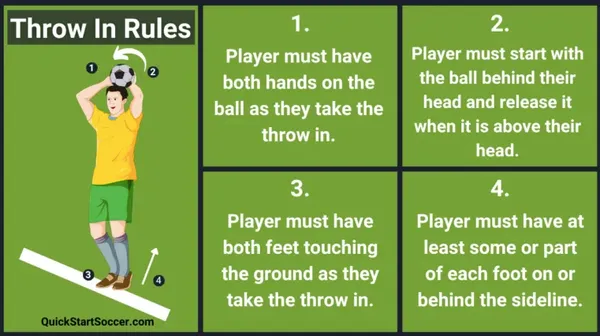Table of Contents
Welcome to Kizworld's comprehensive guide on How to do a throw in basketball. In this guide, we'll provide a step-by-step breakdown of the different types of throws, explain the basic rules and techniques, highlight common mistakes to avoid, and offer valuable tips and drills to help you master the art of throwing. Whether you're a beginner looking to improve your fundamentals or a seasoned player aiming to refine your skills, this guide has everything you need to elevate your game and dominate on the court.
How to do a throw: Master the Art of Throwing
I. First Steps: Getting into Position
First Steps: Getting into Position
Before you take to the court, it's crucial to get your body ready to throw with precision. Here's how to position yourself for a powerful and accurate throw:
1. Stand with Your Feet Shoulder-Width Apart and Your Knees Slightly Bent: This stance provides a stable base and allows you to generate power through your legs. Remember to keep your feet flat on the ground and your weight evenly distributed.
Stance | Benefits | Common Mistakes to Avoid |
Feet shoulder-width apart, knees slightly bent | Stable base, power generation from legs | Feet too close together, knees locked |
Weight evenly distributed | Balance, control | Shifting weight too far forward or backward |
Head up, eyes focused on the basket | Awareness, accuracy | Looking down at the ball, hunching shoulders |
2. Bend Your Arms at the Elbows and Hold the Ball in Front of Your Chest: Your elbows should be slightly bent and your hands should be shoulder-width apart. Keep the ball close to your chest to maintain control.
- Proper Ball Hold: Fingers spread, thumb and index finger forming a "T" shape, ball resting on palm
- Avoid Death Grip: Relax your hands, let the ball rest comfortably
- Pro Tip: Practice holding the ball in different positions to find what feels most natural.
3. Step Forward with Your Opposite Foot: As you prepare to throw, take a small step forward with your opposite foot. This will help you generate momentum and power for your throw.
- Step Right, Throw Left: For a right-handed thrower
- Step Left, Throw Right: For a left-handed thrower
- Synchronize Step and Throw: The step and throw should be fluid and coordinated
II. Mastering the Grip
Mastering the Grip
Mastering the grip is arguably one of the most fundamental aspects of throwing in basketball. A proper grip allows you to control the ball's trajectory, spin, and power. Whether you're a beginner or an experienced player, fine-tuning your grip will significantly improve your overall game.
- Strong Foundation: A firm grip gives you a solid foundation for shooting the ball. It ensures that the ball doesn't slip out of your hands at the most crucial moment.
- Accurate Aim: With a secure grip, you'll be able to aim the ball precisely toward the basket. Inconsistent grip can lead to erratic shots and missed opportunities.
- Control and Spin: A well-executed grip allows you to impart spin on the ball, which dramatically influences its trajectory. Backspin can help you drop the ball softly into the hoop, while topspin provides a more arching shot.
- Shot Consistency: Consistency is key in basketball, especially when shooting free throws or taking important shots. Maintaining a consistent grip helps you reproduce the same shot time and time again.
While gripping the ball, keep your fingers spread out and relaxed, avoiding any tension in your wrist. The thumb should be placed slightly behind the ball, and the index finger should rest on the ball's seam. Experiment with different grip techniques to find what feels most comfortable and effective for you.
With dedication and practice, mastering the grip will become second nature, enabling you to shoot with confidence and precision.
To enhance your throwing skills further, consider these additional tips and drills that will help you excel on the court.
Mistake | Consequence | Correction |
Gripping the ball too tightly | Loss of control and accuracy | Relax your grip and let the ball rest in your hand |
Having your thumb on the front of the ball | Less control and spin | Place your thumb slightly behind the ball |
Using only your fingertips | Reduced power and accuracy | Spread your fingers out and use your entire hand |
III. Developing a Throwing Motion
Developing a Throwing Motion
Developing a proper throwing motion is crucial for accuracy, power, and consistency in basketball. Here are some key steps to help you master the throwing motion:
- Stance: Stand with your feet shoulder-width apart, knees slightly bent, and your non-dominant foot slightly forward.
- Grip: Place your non-dominant hand on the side of the ball, with your fingers spread out and your thumb along the seam. Your dominant hand should be placed on top of the ball, with your fingers curled underneath and your thumb resting on the opposite side of the seam.
- Backswing: Bring the ball back behind your head, keeping your elbow close to your body. Your wrist should be cocked back, and your forearm should be parallel to the ground.
- Forward Swing: As you step forward with your non-dominant foot, swing the ball forward, keeping your elbow close to your body. Your wrist should be flicked forward at the last moment, releasing the ball with a smooth, controlled motion.
- Follow Through: After releasing the ball, continue your throwing motion by following through with your arm and hand. Your arm should finish pointing towards the basket.
Practice these steps regularly to develop a smooth and consistent throwing motion. Remember to focus on accuracy and control rather than just power. With practice, you'll be able to throw the ball with confidence and precision.
Mistake | Correction |
Throwing with your arm instead of your whole body | Engage your legs and core to generate power and accuracy. |
Releasing the ball too early or too late | Time your release so that the ball leaves your hand at the highest point of your follow-through. |
Flicking the ball with your wrist | Use a smooth, controlled motion to release the ball. Avoid flicking or jerking your wrist. |
Not following through with your arm | Continue your throwing motion after releasing the ball to generate more power and accuracy. |
Throwing the ball too hard | Focus on accuracy and control rather than just power. A well-placed shot is more likely to go in than a hard shot that misses the basket. |
By avoiding these common mistakes, you can improve your throwing accuracy and consistency. With practice, you'll be able to make shots from anywhere on the court.
Here are some additional tips for developing a great throwing motion:
- Practice regularly: The more you practice, the better your throwing motion will become. Aim to practice for at least 30 minutes each day.
- Get feedback from a coach or experienced player: A coach or experienced player can help you identify any flaws in your throwing motion and provide tips for improvement.
- Use a variety of drills: There are many different drills that you can use to improve your throwing motion. Some popular drills include the wall pass drill, the partner pass drill, and the shooting drill.
- Be patient: Developing a great throwing motion takes time and practice. Don't get discouraged if you don't see results immediately. Just keep practicing and you will eventually see improvement.
With hard work and dedication, you can develop a throwing motion that will help you become a better basketball player.
If you want to learn more about basketball, check out our other articles on how to improve your basketball skills, the best basketball drills and exercises, and the top basketball players of all time.
IV. Throw Like an Olympian
Throw Like an Olympian
Mastering the Art of Throwing
In the realm of basketball, the ability to throw accurately and effectively is a fundamental skill that separates the ordinary from the extraordinary. Whether you're a seasoned player or just starting out, mastering the art of throwing can elevate your game to new heights. In this section, we'll delve into the intricacies of throwing in basketball, providing you with the knowledge and techniques to become a throwing maestro.
To begin, let's explore the different types of throws commonly used in basketball. The chest pass, a staple of the game, involves holding the ball at chest level and pushing it forward with both hands. The bounce pass, on the other hand, is employed to navigate defenders by bouncing the ball before it reaches the recipient. The overhead pass, often used for long-distance passes, requires the ball to be held above the head and released with a flick of the wrist.
Once you're familiar with the various types of throws, it's time to delve into the basic rules that govern throwing in basketball. Firstly, the ball must be released before it crosses the half-court line, or else it will be considered a backcourt violation. Secondly, players cannot carry the ball while dribbling, as this constitutes a traveling violation. Additionally, double dribbling, which involves dribbling the ball with both hands simultaneously, is also prohibited.
Now that you have a grasp of the basics, let's address some common mistakes that can hinder your throwing accuracy. One prevalent error is releasing the ball too early or too late, resulting in a wayward pass. Another pitfall is failing to follow through with the throwing motion, which can lead to weak and imprecise throws. Furthermore, neglecting to keep your eyes on the target can cause you to lose focus and compromise your accuracy.
To improve your throwing technique, there are several tips you can incorporate into your practice routine. Firstly, focus on developing a strong grip on the ball, ensuring that it rests comfortably in your hands. Secondly, practice throwing the ball against a wall or with a partner, gradually increasing the distance as your accuracy improves. Additionally, engage in drills that challenge your throwing skills, such as passing the ball over obstacles or making pinpoint passes to specific targets.
Finally, let's explore some drills that can help you master the art of throwing in basketball. The chest pass drill involves standing opposite a partner and exchanging chest passes, emphasizing accuracy and consistency. The bounce pass drill requires you to bounce the ball to a partner, who then returns it with a bounce pass, focusing on controlling the ball's trajectory. The overhead pass drill involves throwing the ball over a net or obstacle, honing your ability to make long-distance passes.
By diligently practicing these drills and incorporating the techniques discussed in this section, you'll be well on your way to becoming a throwing virtuoso in basketball. Remember, practice makes perfect, so stay dedicated and persistent in your pursuit of throwing excellence.
Type of Throw | Description |
Chest Pass | Holding the ball at chest level and pushing it forward with both hands. |
Bounce Pass | Bouncing the ball before it reaches the recipient to navigate defenders. |
Overhead Pass | Holding the ball above the head and releasing it with a flick of the wrist for long-distance passes. |
Related Post: How to Do a Handstand
V. Conclusion
With consistent practice and dedication, you can refine your throwing technique and become a more effective player on the court. Remember, mastering the throw in basketball is a gradual process that requires patience and perseverance. Stay focused, learn from your mistakes, and keep honing your skills. As you continue to practice and improve, you'll be able to confidently execute throws with accuracy and precision, leading your team to victory.